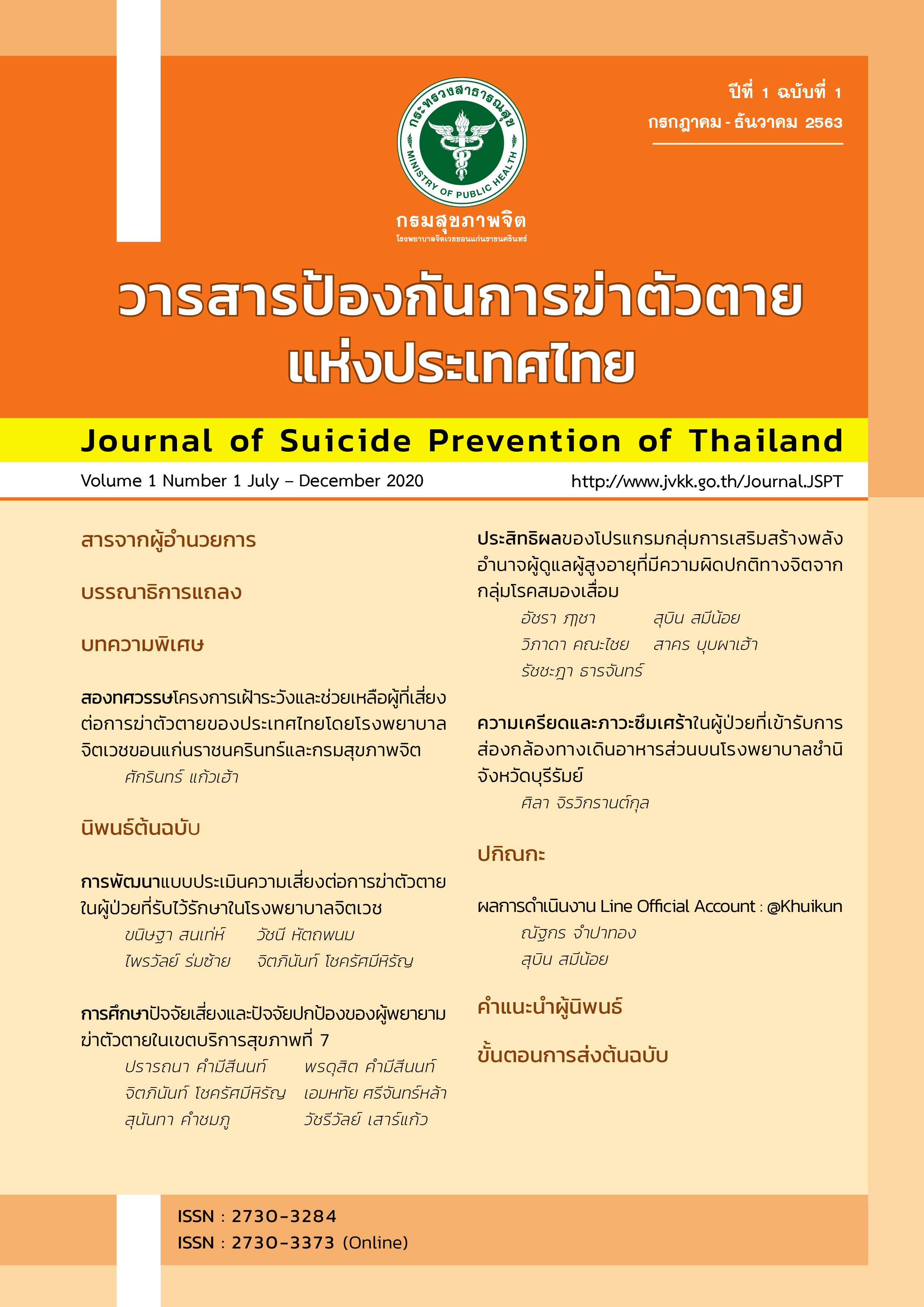The Development of a Psychiatric Inpatient Suicide Risk Assessment
Main Article Content
Abstract
Objectives: 1) To develop a Psychiatric Inpatient Suicide Risk Assessment (PISRA), and 2) To examine PISRA’s structure using factor analysis and its concurrent validity with the Mini International Neuropsychiatric Interview (M.I.N.I.) Module C (suicidality).
Method and method: The research was divided into 3 phases.Phases 1 used an expert panel to develop the PISRA. Phase 2 determined PISRA’scontent validity and understandability of the Thai language. Phase 3 evaluated PISRA’s concurrent validity by correlating PISRA and M.I.N.I. The sample was 165 psychiatric inpatients, selected by purposive sampling according to inclusion criteria. Descriptive statistics explored PISRA’s measure of the degree of suicide risk. Cronbach’s alpha coefficient examined its internal consistency.Factor analysis uncovered PISRA’s structure for construct validity. Spearman’s rank correlation coefficient compared PISRA and M.I.N.I. for concurrent validity. The study was conducted between March 2014 – September 2015.
Results: The 12-item PISRA had 4 domains: 1) depressed mood, 2) suicide,3)Importance behaviors, and 4) suffering. Scores for the degree of suicide were divided into 4 groups:high risk (15-48), moderate risk (7-14), low risk (1-6), and normal or no risk (0 score). The optimum cut point wasthe score of 1.PISRA had a sensitivity of 90.40%, specificity of 87.50%, and accuracy of test 89.70%. The correlation coefficient between PISRA ad M.I.N.I. was strongly positive and statistically significant (p<0.001). The Cronbach’s alpha coefficient of PISRA was 0.81.
Conclusion: The PISRA shows acceptable validity and reliability to evaluate the suicide risk of psychiatric inpatients. The instrument is convenient to use for suicide monitoring.
Article Details
References
WHO.World Report on Violence and Health. Geneva: WHO; 2002.
Gelder M, Gath D, Mayou R, Cowen P. Oxford textbook of Psychiatry.5thed. Oxford University Press release; 2006.
สุชาติ พหลภาคย์. ความผิดปกติทางอารมณ์. ขอนแก่น: โรงพิมพ์ศิริภัณฑ์ออฟเซ็ท; 2542.
Lorenzo RD, Fiorini F, Simoni E, Mimmi S, Rigatelli, Rigatelli M. Suicide and other causes of death in the psychiatric patients of a mental health service over 5 year period. International Neuropsychiatric Disease Journal 2013; 1(1): 46-63.
Novick D, Haro J, Suarez D, Perez V, Dittmann R, and Haddad P. Predictors and clinical consequences of non-adherence with antipsychotic medication in the outpatient treatment of schizophrenia. Psychiatry Res. 2010; 176: 109-13.
โรงพยาบาลจิตเวชขอนแก่นราชนครินทร์.รายงานผลการปฏิบัติงานประจําปีงบประมาณ 2556. ขอนแก่น:
Fawcett J. Treating impulsivity and anxiety in the suicidal patient. Ann N Y Acad Sci 2001; 932(1): 94-102.
Powell J, Geddes J, Deeks J, Goldcare M, HawtonaK. Suicide in psychiatric hospital inpatients: Risk factors and their predictive power. Br J Psychiatry 2000; 176: 266-72.
Lieberman D, Resnik H, Holder-Perkins V. Environmental risk factors in hospital suicide. Suicide and Life-Threatening Behavior. 2004; 34(4): 448-53.
Temkin TM, Crotty M. Suicide and other risk monitoring in inpatient psychiatry. J Am Psychiatr Nurses Assoc. 2004;10(2): 72-80.
Registered Nurses’ Association of Ontario (RNAO).(2007) Assessment and care of adults with suicide ideationand behavior. [ Internet ] 2007 Retrieved from http//www.rnao.org/ .Storage/58/5263_Suicide_-Final-web.pf. [10 Sep 2014].
พันธุ์นภา กิตติรัตนไพบูลย์, มธุรินทร์ คําวงศ์ปัน. ความตรงของเครื่องมือวินิจฉัยโรคทางจิตเวช Mini International Neuropsychiatric Interview (M.I.N.I.) ฉบับภาษาไทย. วารสาร สุขภาพจิตแห่งประเทศไทย 2548; 13(3): 125-35.
โรงพยาบาลจิตเวชขอนแก่นราชนครินทร์.แนวทางการดูแลรักษาผู้ที่เสี่ยงต่อการฆ่าตัวตาย (Clinical Practice Guideline for Suicide Problem). ขอนแก่น: โรงพยาบาลจิตเวชขอนแก่นราช นครินทร์; 2555.
บุปผวรรณ พัวพันธ์ประเสริฐ, มานิต ศรีสุรกานนท์, ชัชวาลย์ ศิลปกิจ, ศุภสิทธิ์ พรรณนารุโนทัย ,พิเชษฐ อุดมรัตน์, อลัน กิเตอร์, และคณะ. Reliability and validation of Thai Version of the Health of the Nation Outcome Scale (HoNOS).จดหมายเหตุทางการแพทย์ แพทยสมาคมแห่งประเทศไทยในพระบรมราชูปถัมภ์ 2550; 90(11): 2487-93.
Streiner DL, Norman GR. Health measurement scales: A practical guide to their development and use.4thed . Oxford: Oxford University Press; 2008.
Lynn MR. Determination and quantification of content validity. Nursing Research1986;35: 382-85.
Polit DF, Beck CT. The content validity index: are you sure you know what’s being reported? Critique and recommendations. Res Nurs Health 2006: 29(5): 489-97.
Beck AT, Steer RA. Manual for the Beck scale for suicide ideation. San Antonio, TX: Psychological Corporation; 1991.
Firestone RW, Firestone LA. Firestone assessment of self-destructive thought. San Antonio, TX: Psychological Corporation; 1996.
Cutcliffe JR, Barker P. The nurses’ global assessment of suicide risk: developing a tool for clinical practice. J Psychiatr Ment Health Nurs 2004; 11: 393-400.
Bjorkdahl A, Nymberg D, Runeson B, Omerov P. The development of the suicidal patient observation chart (SPOC): Delphi study. J Psychiatr Ment Health Nurs 2011; 18:558-561.
บุญใจ ศรีสถิตย์นรากูร. ระเบียบวิธีการวิจัยทางการพยาบาลศาสตร์: The methodology in nursing research. พิมพ์ครั้งที่ 5. กรุงเทพมหานคร: ยูแอนด์ไอ อินเตอร์มีเดีย, 2553.
Pett MA, Lackey NR, Sullivan JJ. Making sense of factor analysis the use of factor analysis for instrument development in health care research. United Stated of America: Sage Publications, Inc; 2003.
มาโนช หล่อตระกูล. การฆ่าตัวตาย: การรักษาและการป้องกัน. กรุงเทพมหานคร: บียอนด์เอนเทอร์ไพรซ์; 2553.
ประภาส อุครานันท์, อภิชัย มงคล, ทวี ตั้งเสรี, วัชนีหัตถพนม, ไพรวัลย์ ร่มซ้าย, ไพลิน ปรัชญคุปต์. การพัฒนาแบบคัดกรองผู้ที่สี่ยงต่อการฆ่าตัวตาย(SU-9). ขอนแก่น: คลังนานาวิทยา; 2555.
กัลยา วานิชย์บัญชา. สถิติสําหรับงานวิจัย. พิมพ์ครั้งที่ 5. กรุงเทพมหานคร: ธรรมสาร; 2553.
Fowler J, Jarvis P, Chevannes M. Practice statistics for nursing and health care. New York:
Beck AT, Schuyler D, Herman I. Development of suicidal intent scales. In: Beck AT, ResnikHLP, Lettieri DJ. editors. The prediction of suicide. Bowie, MD: Charles Press; 1974.
จิราพร เขียวอยู่. วิธีสถิติสําหรับการวัดด้านสุขภาพ statistical Methods for Health Measurement. ขอนแก่น: คณะสาธารณสุขศาสตร์ มหาวิทยาลัยขอนแก่น: 2557.
Altman DG, Bland JM. Diagnostic test. 1: Sensitivity and specificity. Br Med J. 1994; 308: 1552.


